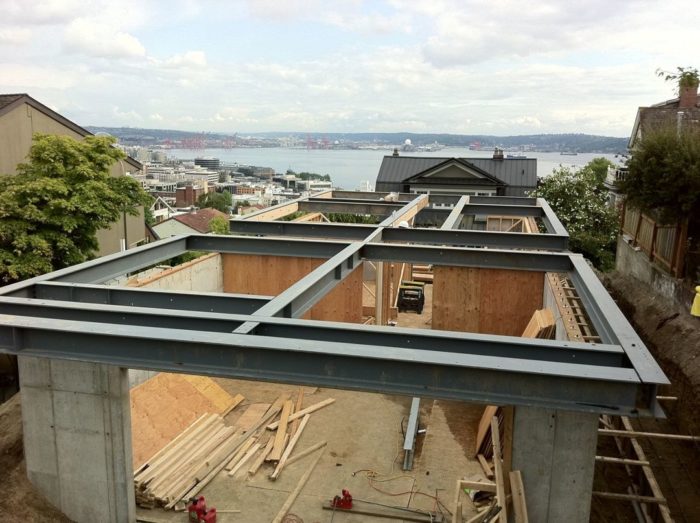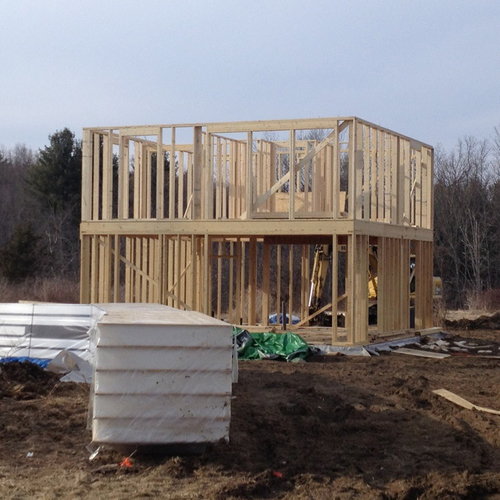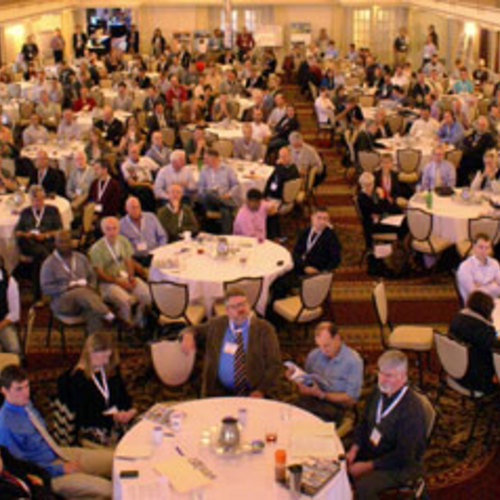
Will the steel mean future rot?
Steel I-beams that support cantilevered floors in this modernist Seattle home are proving difficult to insulate effectively.Brandon M. is building a three-story house in Seattle whose design includes cantilevers on the second and third floors. The designer has specified steel I-beams to provide the structural support in this modernist design, and this is what’s giving Brandon pause for thought.
Although Seattle’s climate isn’t exactly arctic, it gets cold enough. The beams will not be exposed to the elements, but are located close to the outside of the building, and Brandon fears the steel might wick in cold temperatures. That could lead to condensation inside the building that eventually may rot the wood framing joined to the steel.
As originally planned, the bottom flanges of the I-beams would get a scant 1/2 in. (R-2.5) of insulation. Would that be enough to head off the problems he envisions? Brandon asks in this Q&A post. Further, are there products designed for this application? And, does anyone have suggestions about the details?
Brandon’s building dilemma is the topic of this week’s Q&A Spotlight.
‘Back to the drawing board’
The design makes GBA senior editor Martin Holladay cringe.
“I would talk to your architect about changing the design,” he says. “You don’t want steel beam cantilevers penetrating your thermal envelope. Back to the drawing board.”
Holladay and others react strongly to Brandon’s original description of the project because it suggests the beams would actually penetrate the building envelope.
This kind of design, writes Jesse Thompson, are “classic leak points on decks and overhangs in a marine climate, and very tricky to seal where they enter the building. They can wick long distances if they get a chance.”
Brandon clarifies: “The steel beams are fully encased by…
Weekly Newsletter
Get building science and energy efficiency advice, plus special offers, in your inbox.

This article is only available to GBA Prime Members
Sign up for a free trial and get instant access to this article as well as GBA’s complete library of premium articles and construction details.
Start Free TrialAlready a member? Log in















6 Comments
What is sad is if any one of
What is sad is if any one of these people--Owner, Architect, Contractor, Building Inspector--any one of them, had said before they dug a hole 'Hmm, how we gonna insulate this monster?' it could have been a pretty efficient structure. Not a net zero or anything, but not too bad[I have no concept of what direction it faces though]
A fifty year old listens to classic rock and thinks the 1971 Corvette was the prettiest car ever, was taught by a guy who listens to Brubeck and thinks the 1957 California Spyder is the prettiest car ever, and thinks Bauhaus is the it style.
How we ever move forward is a miracle.
That anyone asks the questions is part of that miracle.
I hope he gets the right answers
During my time in
During my time in architecture school in the early eighties there was much discussion of the work of James Stirling in this context. The signature buildings on which he built his career were notable for developing the greatest possible surface area in relation to usable volume and much of that surface was glass. Of the award-winning History Faculty Building at the University of Cambridge in England it was later written: "Although the building was admired by students of architecture it is less well regarded by those who have to work in it. Expensive modifications were necessary to render it usable, and in 1984 the university came close to pulling the whole thing down." With regard to solar orientation there is also this: "it was discovered that a part of the original site was unavailable to the University and the building was turned 90 degrees to fit the land available."
steel in and of itself isn't
steel in and of itself isn't inherently bad - in this case it's just not used in a thermally efficient manner. i can point to a multitude of steel buildings that are better at taking this into account. and there are applications for cantilevering steel through the envelope without compromising the envelope, as i mentioned in the original post.
a bigger issue is when renowned architects tell their employees (or even worse, students) that as long as the steel is 1/2" in thickness, it doesn't cause any thermal bridging...
In Seattle?
While the energy penalty posed by the thermal bridging is an obvious concern, condensation is not something I would worry about...especially at this point in construction. No, it's not ideal or even good practice but it's not something I would panic about.
I looked up the average lows for Dec. and Jan. in Seattle: 36F. It just doesn't get cold enough for long enough to produce enough condensate to cause a problem. By problem I mean rot, insulation dampening, water staining of interior finishes, etc. Likewise, it doesn't get that hot in the summer, so people running air conditioning in the summer aren't going to get the problem in reverse either.
I work primarily in Minnesota. I've seen some pretty spectacular condensation problems. One building I renovated was a manufacturing use with high humidity required for some processes. The building was old and had a poorly insulated metal roof deck. When it got below 10 degrees or so it basically rained indoors. Translate that to a Seattle house and as long as the residents don't go hog wild with humidifiers in the winter they should be fine. Then again, we're talking about Seattle where the heating season is the same as the rainy season so I'm guessing no one ever needs extra humidity.
Trying to help the best way I know how to
Bear with me as I'm not the most well spoken, so I hope this makes sense to you all; hopefully, I'm not too long winded and confusing.
I definitely agree with the general consensus that this project should have had more than the cosmetics and structural integrity on the planning table, but unless you're going to undo what has been done already, it is time to move on.
I am in a similar climate down here in southern coastal NJ, and am also building a house with a considerable amount of steel and concrete. As the homeowner, I was allowed to be my own architect and partial engineer (I had the ideas, but had an engineer verify them), which means my methods of construction aren't always common protocol. Anyway,I will explain what I did to address my thermal bridging and moisture problem, which may have some things in common with your situation.
I am certainly not as adept as the experts on this site, so I am sure my methods have their problems, but hopefully my example can be a starting point in which a creative model can be developed to solve your (and possibly my own) problem.
OK..my house is basically 42' X 36', with a 10X15 notch taken out (sort of like Utah shape). This is important, because that "notch" actually becomes a covered porch, and this is where my thermal bridging/moisture problem is.
My walls are poured icf, and there are many window/door openings that extend to the top of the pour; in other words, the top edge of all my walls are really "mini" walls separated by window and door openings. To tie the walls together, I anchored a metal plate(s) in the concrete in each wall section, and welded 8" i-beams to each other and to the anchors, along the entire top perimeter of all my walls. I tacked the steel joists to the beam as well. The web of the i-beam is about 4.5 inches from the exterior, and the flange ends are about 2.5 inches away---not as bad as the 1/2 inch space from your example, but bear with me.
Going back to the front porch. I wanted a concrete floor above the first floor, and also wanted that floor to continue past the exterior walls where the notch is in order to have a complete 42X36 slab and a covered front porch. What I did was "complete the square" by welding 12" steel i-beams to the existing 8" i-beam perimeter, thus extended both walls where the "notch" was. I put a steel column in the corner to carry the load.
Where the 12" beams connect to the 8" perimeter beam, I set them in a couple inches more so that I could have more than 2.5 inches from the edge of the flange to the exterior of the wall. Also, nothing is protecting the perimeter i beam nor the joist edges welded to it. Lots of thermal bridging potential. Furthermore, the non-exposed concrete floor was to be poured on corrugated decking, but I chose to pour the exposed portion without it. I hope this makes sense.
First of all, I sprayed the steel with the zinc galvanizing paint (obviously after all my welding). Next, although VERY labor intensive--I'm talking a solid month for myself to do (no other help), I built all the forms necessary for both the inner and outer edges of the second floor slab. The trick is that I decided to wrap the entirety of the 12" exposed I-beam with 3" of concrete past the flange ends, which is why I offset the exposed beams inward by 3 inches. Building forms around the beams and also to support the concrete floor between them was tough, but I got it done. Next, from the inside of the house, I wanted the concrete floor to monolithically catch the last couple inches of the floor joists I tack welded to the perimeter beam, and also to protect the outer portion of the i-beam. I formed the outside forms readily enough, but on the inside, I had to specially cut over 100 boards to fit between the c-joists (such that the concrete didn't pour straight into the house), then brace them for the pour...
After the pour, I will be insulating with 2" xps board around the outer edge of every piece of exposed concrete (the entire perimeter of the house and around the concrete wrapped 12" beams), and 4" under the exposed concrete floor.
I hope this has made sense and has helped some. Good Luck with your project.
This and that -- it's all in the details
As an architect, I find the article presents a number of interesting issues, many of which are germane and mundane to my everyday practice. A trite way to put it is to say that these are the "things that keep us awake at night," amongst a host of others. There are a number of points to remember as one reads through this.
To start with, steel framing isn't inherently bad. In many ways it's quite a wonderful component and tool for delivering real performance, but like any component, it has design constraints that must be accommodated in the project's execution. A critical question is, "Why was steel chosen for the framing?" The answer to that is almost certainly that steel framing was the most affordable way to accomplish the design.
Now this is where things get trickier. Suddenly "the design" leaps into prominence, and in fairness we have to ask why. This is Brandon's project, the site, the original idea, the budget all started with him. In Seattle, siting and design aesthetics are all about the view, which is evidenced in the marine views of the article's photos, and these factors are central to the Owner's project initiation. He's the client who pays the bills, so he surely must have had some say-so in approving of the final design that ultimately led to the criticized cantilevers and modernist aesthetic. It's safe to say that the Owner's needs drive the design process; they also drive the construction process.
It's the construction process that drives building material choices for such unsexy and invisible items as steel framing. The reason for this is that there are other structural solutions to the project's design challenges, but they either trigger design compromises or simply cost too much. Again, the client has a huge role in guiding the architect's direction on subjects like this and on how much attention gets paid to things like green design or which furniture goes into the project -- it's all part of the Owner's vision and budget. The client has to be willing to pay for the aesthetics they demand or they have to be willing to compromise on those aesthetics, which in this case would have meant having smaller windows and thicker spandrels. Was this leeway allowed to the architect?
And about that architect. The article is spot-on in knocking the architect if he/she failed to address these issues, but without having all the details of what has transpired, we are going out on a limb by pinning all the blame on the architect. Maybe Brandon only budgeted design fee for the conceptual and structural design, this is very common nowadays and it's the builder who gets left to iron out the detailing. Maybe he hired a structural engineer to design the house -- don't laugh, I've seen this many, many times, and structural engineers are good at … structural design. Without forgiving the architect, I'll point out that, just like builders and engineers, there are good ones and bad ones, new ones and very experienced ones, and again just like the other building professionals, there is often a corollary between skill and cost. With such an apparently sophomoric flop on the thermal performance, I am left wondering if the total budget has again influenced the client's decisions, and thereby the challenges noted in the article. Head's up Brandon, you get what you pay for in the construction game.
As for straightening out what appears to be serious trouble, James Morgan's comment, "Get the drawings reviewed by a competent third-party engineer before it’s too late," isn't particularly helpful because it appears he is unaware of the roles of AEC professionals. It is the architect whose role it is to ensure the enclosure (i.e., waterproofness and thermal) performance is satisfactory. Brandon is better advised to seek a 3rd party architect whose practice specializes in the building envelope, and while this is arguably something that all architects should have completely in hand, there are specialists for this subject. Better yet, if this all is in fact the architect's flop, it shouldn't be too hard for Brandon to convince his architect that now is the time for said architect to hire the specialist him/herself while there's still time to solve the problem, or be at risk of a failed contract and punishing lawsuit now or in the future after a failure.
Log in or become a member to post a comment.
Sign up Log in